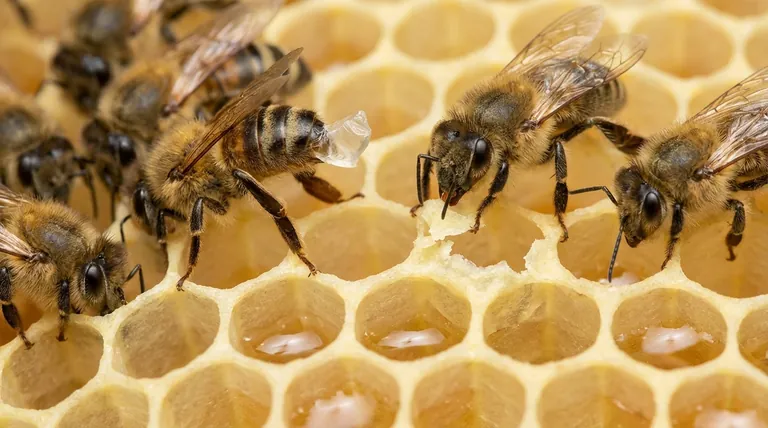In essence, worker bees produce beeswax by converting sugar from honey into wax, which is secreted from specialized glands on their abdomens. This secreted wax emerges as small, clear scales, which the bees then chew and manipulate with their mandibles to build the iconic hexagonal cells of their honeycomb.
Bees are not gatherers of wax, but manufacturers. They function as tiny biological factories, consuming honey as fuel to produce a unique thermoplastic building material essential for the hive's structure and survival.

The Biological Engine of Wax Production
The creation of beeswax is a specialized biological function performed exclusively by young worker bees, typically those between 12 and 20 days old. It is a metabolically intensive process that relies on a specific set of glands and a high-energy diet.
The Source: Abdominal Wax Glands
Beeswax originates from four pairs of specialized glands located on the underside of a worker bee's abdomen. These glands develop after a bee emerges from its cell and become most productive during the second and third weeks of its life.
From Liquid to Solid Scale
The glands convert sugars from honey into a liquid wax that is secreted through small pores. Upon exposure to the air, this liquid hardens into small, flat, and transparent flakes known as wax scales.
The Fuel: Honey Consumption
Wax production is incredibly energy-intensive. Bees must consume large quantities of honey to fuel their wax glands. It is estimated that a colony must consume six to eight pounds of honey to produce just one pound of beeswax, making it a very valuable resource for the hive.
From Raw Material to Architectural Marvel
A raw wax scale is brittle and not immediately useful. The bees must process this material to transform it into the strong, pliable substance needed to construct the comb.
Harvesting the Wax Scales
A worker bee uses a specialized spine on its middle leg to pry the wax scales from its own abdomen. It then transfers the scale to its front legs and brings it forward to its mouthparts.
Chewing and Shaping
The bee then uses its mandibles (jaws) to chew the wax scale. This act of mastication mixes the wax with saliva, making it soft and pliable. This process also changes the color of the wax from transparent to the more familiar opaque white.
Constructing the Comb
Once the wax is properly softened, the bee carries it to the construction site and meticulously molds it into place. By working together, thousands of bees form and shape this processed wax into the perfectly uniform, six-sided cells of the honeycomb.
Understanding the Trade-offs
The decision to produce wax is not taken lightly by the colony. It involves significant costs and requires specific environmental conditions, representing a major investment of the hive's resources.
The High Energy Cost
The 8:1 ratio of honey consumed to wax produced means that wax creation directly competes with winter survival stores and brood rearing. A colony will only produce wax when there is a strong nectar flow and a clear need for more storage or brood space.
The Need for a Warm Environment
Wax glands function most efficiently at warmer temperatures. Bees will often form a dense cluster, vibrating their wing muscles to raise the internal hive temperature to an optimal 91-97°F (33-36°C) to facilitate wax secretion.
Key Takeaways of Wax Production
- If your primary focus is the biology: Remember that wax is a metabolic product secreted from specialized glands, not a material collected from the environment.
- If your primary focus is the engineering: Recognize that bees process this raw secretion, chewing it into a perfect, pliable building material for the honeycomb.
- If your primary focus is the hive's economy: Understand that wax production is energetically expensive, requiring a massive consumption of honey to create the hive's foundational structure.
Ultimately, beeswax is a testament to the honey bee's ability to transform its primary food source into the very architecture of its world.
Summary Table:
| Key Aspect | Description |
|---|---|
| Producer | Young worker bees (12-20 days old) |
| Source | Secreted from 4 pairs of wax glands on the abdomen |
| Raw Material | Clear, hardened wax scales |
| Fuel Required | 6-8 lbs of honey to produce 1 lb of wax |
| Final Product | Chewed, pliable wax used to build hexagonal honeycomb cells |
Equip Your Apiary with the Right Tools
The intricate process of wax production is fundamental to a thriving hive. For commercial apiaries and distributors, having durable, high-quality equipment is just as critical. HONESTBEE supplies the essential beekeeping supplies and equipment that support the natural behaviors of your bees, from hive construction to honey production.
Contact our wholesale experts today to discuss how our products can help build a stronger foundation for your beekeeping business.
Visual Guide

Related Products
- Electric Flatting and Embossing Machine with Tray for Beekeeping
- Electric Beeswax Flat Sheet Machine with Operating Tray for Wax Processing
- 8-Frame Electric Self-Reversing Honey Extractor Spinner for Commercial Honey Extraction Equipment
- Professional Thermostatic Conical Honey Melter
- HONESTBEE 72 Frame Industrial Electric Honey Extractor for Beekeeping
People Also Ask
- How does pressed honey compare to extracted or crush-and-strain? Unlock the Full Flavor of the Hive
- What customization options are available with fully automatic wax foundation machines? Tailor Sheets for Any Hive Frame
- What is the importance of soaping the rollers during milling? Prevent Wax Adhesion & Equipment Downtime
- What are the main methods of honey extraction? Optimize Your Harvest for Maximum Yield
- What tools are used to cut wax foundations? The Essential Guide for a Perfect Fit



















